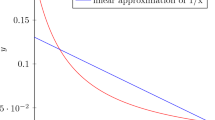Abstract
We propose a novel area/time efficient elliptic curve cryptography (ECC) processor architecture which performs all finite field arithmetic operations in the discrete Fourier domain. The proposed architecture utilizes a class of optimal extension fields (OEF) GF(q m) where the field characteristic is a Mersenne prime q = 2n − 1 and m = n. The main advantage of our architecture is that it achieves extension field modular multiplication in the discrete Fourier domain with only a linear number of base field GF(q) multiplications in addition to a quadratic number of simpler operations such as addition and bitwise rotation. We achieve an area between 25k and 50k equivalent gates for the implementations over OEFs of size 169, 289 and 361 bits. With its low area and high speed, the proposed architecture is well suited for ECC in small device environments such as sensor networks. The work at hand presents the first hardware implementation of a frequency domain multiplier suitable for ECC and the first hardware implementation of ECC in the frequency domain.
Similar content being viewed by others
References
Bailey DV, Paar C (1998) Optimal extension fields for fast arithmetic in public-key algorithms. In: Krawczyk H (ed) Advances in cryptology—CRYPTO ’98, vol LNCS 1462. Springer, Berlin Heidelberg New York, pp 472–485
Bailey DV, Paar C (2001) Efficient arithmetic in finite field extensions with application in elliptic curve cryptography. J Cryptol 14(3):153–176
Baktır S, Sunar B (2005) Finite field polynomial multiplication in the frequency domain with application to elliptic curve cryptography. Technical report. Worcester Polytechnic Institute, Worcester
Baktır S, Sunar B (2006) Finite field polynomial multiplication in the frequency domain with application to elliptic curve cryptography. In: Proceedings of the 21st international symposium on computer and information sciences (ISCIS 2006). Lecture notes in computer science (LNCS), vol 4263. Springer, Berlin Heidelberg New York, pp 991–1001
Batina L, Örs SB, Preneel B, Vandewalle J (2003) Hardware architectures for public key cryptography. Integr VLSI J 34(6):1–64
Blake IF, Seroussi G, Smart N (1999) Elliptic curves in cryptography. Mathematical Society Lecture Notes Series 265. Cambridge University Press, London
Burrus CS, Parks TW (1985) DFT/FFT and convolution algorithms. Wiley, New York
Kalach K, David JP (2005) Hardware implementation of large number multiplication by FFT with modular arithmetic. In: Proceedings of the 3rd international IEEE-NEWCAS conference. IEEE, Piscataway, pp 267–270
Koblitz N (1987) Elliptic curve cryptosystems. Math Comput 48:203–209
Kumar S, Girimondo M, Weimerskirch A, Paar C, Patel A, Wander AS (2003) Embedded end-to-end wireless security with ECDH key exchange. In: 46th IEEE midwest symposium on circuits and systems, Cairo, pp 27–30 December 2003
Lee M-K, Kim KT, Kim H, Kim DK (2006) Efficient hardware implementation of elliptic curve cryptography over GF(p m). In: Proceedings of the 6th international workshop on information security applications (WISA 2005). Lecture notes in computer science (LNCS), vol 3786. Springer, Berlin Heidelberg New York, pp 207–217
Menezes AJ, van Oorschot PC, Vanstone SA (1997) Handbook of applied cryptography. CRC, Boca Raton
Miller V (1986) Uses of elliptic curves in cryptography. In: Williams HC (ed) Advances in cryptology, CRYPTO ’85, vol LNCS 218. Springer, Berlin Heidelberg New York, pp 417–426
Öztürk E, Sunar B, Savas E (2004) Low-power elliptic curve cryptography using scaled modular arithmetic. In: Proceedings of the workshop on cryptographic hardware and embedded systems (CHES 2004). Lecture notes in computer science (LNCS), vol 3156. Springer, Berlin Heidelberg New York, pp 92–106
Pollard JM (1971) The fast fourier transform in a finite field. Math Comput 25:365–374
Rader CM (1972) Discrete convolutions via mersenne transforms. IEEE Trans Comput C-21(12):1269–1273
Rivest RL, Shamir A, Adleman L (1978) A method for obtaining digital signatures and public-key cryptosystems. Commun ACM 21(2):120–126
Satoh A, Takano K (2003) A scalable dual-field elliptic curve cryptographic processor. IEEE Trans Comput 52(4):1–64
Tolimieri R, An M, Lu C (1989) Algorithms for discrete fourier transform and convolution. Springer, Berlin Heidelberg New York
Woodbury A, Bailey DV, Paar C (2000) Elliptic curve cryptography on smart cards without coprocessors. In: IFIP CARDIS 2000, fourth smart card research and advanced application conference. Kluwer, Bristol, pp 20–22
Author information
Authors and Affiliations
Corresponding author
Additional information
Selçuk Baktır conducted his work in part while he was a visiting researcher at the Communication Security Group at Ruhr-University Bochum, Germany.
Selçuk Baktır and Berk Sunar were supported by the NSF CAREER award ANI-0133297.
Rights and permissions
About this article
Cite this article
Baktır, S., Kumar, S., Paar, C. et al. A State-of-the-art Elliptic Curve Cryptographic Processor Operating in the Frequency Domain. Mobile Netw Appl 12, 259–270 (2007). https://doi.org/10.1007/s11036-007-0022-4
Received:
Accepted:
Published:
Issue Date:
DOI: https://doi.org/10.1007/s11036-007-0022-4




